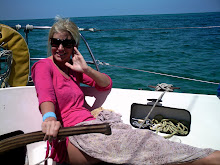Once we'd rounded the point and turned north from Indian Hole, once all sails set and trimmed, there wasn't much to do besides sit back and enjoy. But, Pete and I did get a little exercise right at the end, beating our way up into Calabash Bay through a break in the reef that forms its western barrier. Just five tacks is all it took, but that was enough work with the sheets to leave me sore and out of breath. [At this point I should probably clarify that the sheets to which I refer are the ropes that control the sails, as in "port jib sheet" or "main sheet", not "bed sheet"] During the long period of idleness on San Salvador and again in Georgetown the carefully cultivated calluses on my palms had softened and begun to peel off. Now, my hands were throbbing.
We set anchor a safe distance offshore and, it being mid-afternoon, decided to head off for some exploring. Our little Seagull had refused to start the last time we'd tried in Georgetown and neither of us wanted to waste daylight working on it now. Rowing against the wind the quarter mile to the beach didn't sound very pleasant either. So, we pulled on our snorkeling fins, flopped over the side, and swam for it. Fifteen minutes later we were still swimming. Another five after that and we'd dragged ourselves up onto the sand, shucked our fins, and set out.
We headed first for a nearby estuary. The tide was out and great, white sand flats lay empty and exposed for our inspection. The surfaces of these flats were dimpled with small, steep depressions which had remained full of water as the tide receded. Scattered throughout these isolated pockets, hundreds of jellyfish of all colors and sizes clung desperately to life until the changing of the tides would set them free again.
The sand flats sloped imperceptibly downwards to the deep channel. Here, the water puddles grew larger and began to merge together until the water to sand surface ratio was reversed. All was water with only the isolated tops of the small, steep hills poking above like little islands.
It was an interesting phenomenon of these tidal flats that while some of the little islands were hard packed sand that would support our weight with barely a divot, others were soft and waterlogged and allowed us to sink down to our ankles or more.
Now, Pete and I discovered a new game; racing each other at full speed across the flats, leaping from island to island. It was a game of chance as much as skill. We each never knew when we would land on a soft island and be instantly dumped on our faces. Competition was fierce. Crashes were spectacular.
We went on to explore some coral caves, found a buoy and, still covered in sand from our foot races, wandered our way into the swank Club Santa Maria to check the weather forecast. Later, when wading out into the deeper water to begin our swim home, a man came motoring up to us in his dinghy. His name was Frank. He's seen us swim ashore the first time and thought that this time we might like a ride back to our boat. We gratefully accepted.
It was Happy Hour at the club's bar Frank informed us and the Pina Coladas were the best he'd ever had in his life. That was enough for us. We dashed back aboard Strolla, pulled on some shirts and, still barefoot, hopped back in the dinghy with Frank to zoom off to the bar. The Pina Coladas were just as delicious promised.




No comments:
Post a Comment